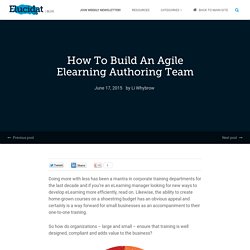

Mobile Learning and Statistics. 16 mobile market statistics you should know in 2016. While smartphones are now firmly established as an integral part of our lives, the mobile world continues to change rapidly as new types of devices, services and technologies come and go.

It is of utmost importance for businesses to stay on top of the ever-changing mobile world. Here is a curated list of 16 most recent statistics which will help you better understand the state of the mobile industry in 2016. 1. There are over 2.6 billion smartphone users worldwide According to Statista, the overall number of mobile phone users reached 4.43 billion in 2015. The number of people with a “smartphone subscription” reached 2.6 billion in 2015, according to Ericsson Mobility Report. Sources: 1, 2, 3 2. Top 5 smartphone vendors based on IDC’s shipment statistics for Q4 2015 were Samsung (21.4% market share), Apple (18.7% market share), Huawei (8.1% market share), Lenovo (5.1% market share) and Xiaomi (4.6% market share). Sources: 1, 2 3. Sources: 1, 2 Sources: 1, 2.
Mobile Learning and Statistics. 16 mobile market statistics you should know in 2016. SR 1382A UPRI future work skills sm. Exploit the latest trends in rapid e learning and agile development (Nov 09) E-Learning Training Academy - e-learning resources for corporate trainers. The eLearning Coach - Get smart about designing learning experiences. How To Build An Agile Elearning Authoring Team – Elucidat Blog. Doing more with less has been a mantra in corporate training departments for the last decade and if you’re an eLearning manager looking for new ways to develop eLearning more efficiently, read on.

Likewise, the ability to create home-grown courses on a shoestring budget has an obvious appeal and certainly is a way forward for small businesses as an accompaniment to their one-to-one training. So how do organizations – large and small – ensure that training is well designed, compliant and adds value to the business? With the growth in eLearning authoring tools, seemingly anyone can be their own eLearning developer, designer and project manager. The benefit of this do-it-yourself approach is that organizations can save thousands from their budgets, whilst retaining complete control over the content and design. With this being the case, commissioning departments no longer require the services of eLearning agencies – but that doesn’t mean they don’t need an agile eLearning authoring team. 1. What Does It Mean to Be Agile? by Megan Torrance. “Using an agile project-management approach, a team builds their deliverables in small increments, releases usable training frequently, and uses those releases to collect feedback early and often.

Successive approximation, aka iterative development, is central to agile methodology. It’s how you proactively gather feedback and, yes, changes, so you can further improve your product.” “Agile” is almost as hot these days as “mobile” and “gamification” when it comes to training industry buzz words. Sure, agility sounds like it could be a cornerstone of your workplace wellness program, but in fact it has a lot more to do with the overall health of your projects. What is agile project management? Agile project management is an approach for managing a creative project process, where team members both accept and expect change along the way. How agile works for eLearning development There’s a lot to it. Skills Your e-Learning Team Needs in 2016 and Beyond. Average skills are no longer enough to get or keep an average job, and you need even more when you are working in the technology-driven world of e-learning.

As computers and machines take on almost Orwellian levels of skills and abilities, once adequate human skill sets simply aren't cutting it anymore. To give you and your e-learning team a fighting chance against the machines, learn, love and live these skills to succeed in 2016 and beyond. 1) Adapt and Move with Change You know how it is when you design a completely perfect eLearning course from the start, and it totally answers the question or solves the problem you were trying to fix, and that same product continues to work without fail for years to come? Yeah, I don’t know how that is and no one else does either because it DOES NOT HAPPEN. The skills of adaptability and agility are more important than ever because the days of releasing a single product as is and having it solve the problem are gone.
A-Accept Change.